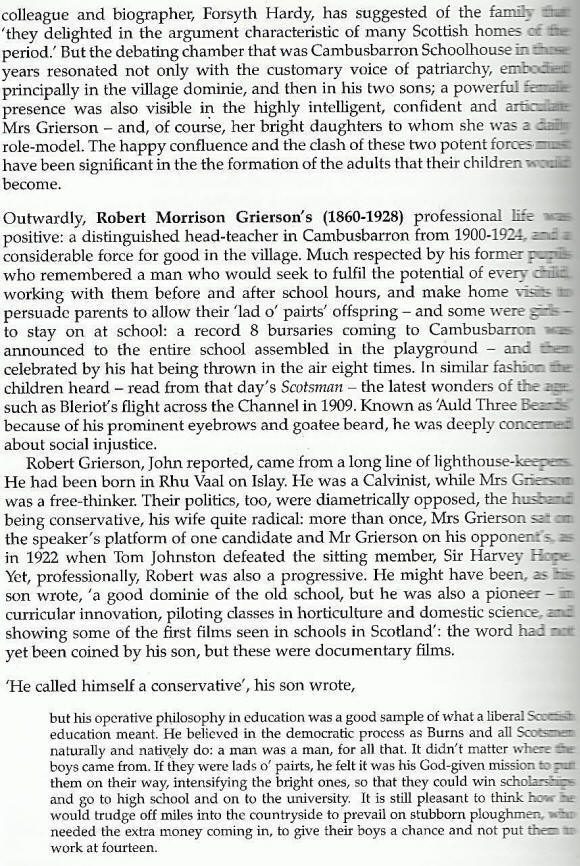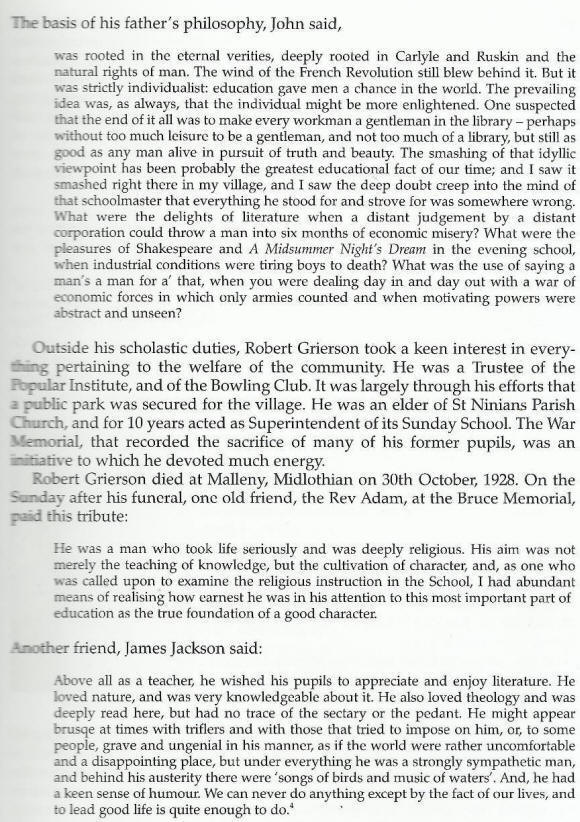GRIERSON,
a surname synonymous with MacGregor (see MACGREGOR, surname of), and
sometimes abbreviated into Grier, or Greer.
The family
of Grierson of Lag in Dumfries-shire is descended from Gilbert, 2d son
of Malcolm, dominus de MacGregor, who died in 1374. Before 1400,
gilbert MacGregor received charter from “George de Dunbar, earl of
March,” of “the Netherholm of Dalgarnock,” to him and his “heirs male,
to be called by the surname of Grierson.” The said earl also granted
charter, dated at Dunbar, 1400, “of the lands of Airdes, &c., lying in
the barony of Tyberis, and shire of Dumfries, to the said Gilbert, for
his many good deeds done to the said earl.” The lands of Lag, from
which the family take their title, were conveyed to the said Gilbert
by the earl of Orkney, by charter, dated Dec. 6, 1408, which describes
them as “the lands of Lag, lying in the Brokenbarony, among the monk
lands of the monastery of Melrose, giving yearly a pair of gilt spurs
at the castle of Dumfries, as blench farm.” The family thus appear to
have settled in Dumfries-shire, from the Highlands, in the beginning
of the 15th century. The said Gilbert Grierson is designed
armour-bearer to Archibald, earl of Douglas, lord of Galloway and
Annandale, in a charter of the lands of Drumjoan, in 1410. He had 2
sons, gilbert, who married Janet de Glendoning of Parton, and Vedast.
The latter succeeded in 1457, and had two sons, Gilbert, who
predeceased his father, and Roger, who succeeded, and married Isobel,
daughter of David de Kirkpatrick, with whom he got the lands of “Rocail,”
now Rockhall. In Playfair’s British Family Antiquity, vol. 8, app. p.
ccxlviii., it is stated that it was his grandfather, Gilbert Grierson,
who married Isobel de Kirkpatrick, lady of Roukel, she dying in 1472,
and the grandson’s wife’s name is given as Isobel only, the surname
being a blank. Roger was wounded at the battle of Sauchieburn in June
1488, and died soon after. He had 2 sons, Cuthbert, who succeeded his
father, and died in 1513, and Roger, his successor, who married Agnes
Douglas, daughter of James, 5th baron of Drumlanrig, and
was killed at Flodden, 9th September 1513. He had three
sons, 1. John, 2. Gilbert, married Jane Maxwell of the Kirkconnell
family, issue, a son, who died canon of St. Peter’s Church, Anderleb,
near Brussels, in 1644; 3. Cuthbert, killed in battle in 1514; and
three daughters.
John, the
eldest son, as heir and successor to his uncle Cuthbert, obtained a
charter in 1517 under the great seal, “de totis et integris terris de
messuagis lands et Grenan jacentibus infra commitatum de Dumfries quae
fuerunt dicti quondam Cuthberti et in meritis quondam patris Domini
regis recognitae fuerint ob alienationem earundem.” John died in 1566.
He was twice married, 1st to Nicholas Herys, and 2dly to
Egidia or Giles Kennedy, daughter of Sir John Kennedy of Culzean, and
had 3 sons, William, who predeceased him, Robert, of whom afterwards,
and John, the latter two sons of the 2d wife.
There was a
John Grierson (supposed to belong to this family) who was principal of
King’s college and university, Old Aberdeen, in 1500. He was a
Dominican friar, greatly esteemed for his learning, and for thirty
years was provincial of his order. According to Dempster, he wrote two
books concerning the miserable state, poverty, and decay of his order
in Scotland. One of them was a collection of Letters, published in the
History of that Order, written by the R.F. Plaudius of Bononia. He was
the last provincial Dominican friar in Scotland, and died at Aberdeen
in 1564.
A branch of
this family possessed the estate of Straharlie, the first of which was
named Robert. His eldest son, James, was a knight banneret, and known
by the name of “Sir James Grier, knight.” For his faithful adherence
to Charles I., he was driven from the tower of Lag by Cromwell. With
his family he went to Cumberland, where his eldest son, Henry, married
Mary, daughter of General Turner of Turnerstead, n that county.
General Turner’s son, Thomas, married Ann, daughter of Sir James Grier
and sister of Henry. They went to Ireland, and founded the family of
Turner of Turner Hill, county Armagh. Henry Grier also emigrated to
Ireland, settled at Redford, near Grange, county Tyrone, and was
ancestor of the family of Greer of Grange MacGregor in that county.
The family of Lag seem to have shortened their name to Grier, which
they bore for some generations, in consequence, it is supposed, of the
proscription of the name and clan of MacGregor.
Roger
Grierson of Lag, 2d but eldest surviving son of John, “Baron of Lag,”
above mentioned, was one of the subscribers of the bond of association
entered into, in 1567, by many of the nobles and gentlemen of
Scotland, for the support of the authority of the infant king, James
VI. He died in 1593.
His only
son, Sir William Grierson of Lag, joined the Maxwells of Nithsdale
against the Johnstones of Annandale, and fought at the sanguinary
battle of Dryfe Sands, when the former were defeated, with a loss of
700 men, on 7th Dec. 1593. He was knighted by King James
VI. About 1608, and in 1623 appointed the keeper of certain rolls. He
died about 1629. He married Nicolas Maxwell, only daughter of William,
Lord Herries, whom he ‘seized in the lands of Rocail, for the trouble
and care tane by her, upon his direction, in eddyfing and biggng the
said place of Rocail, lately constructed by him, and others, his
honourable affairs, according to the duty of ane loving wife,” 1613.
He had one son, Sir Robert, and two daughters, 1. Agnes, married John,
eldest son and heir of Stephen Laurie of Maxwellton; 2, Isobel,
married Edward Maxwell of Lagan.
The only
son, Sir Robert, knighted in his father’s lifetime, was a member of
the Scots parliament. He married in 1622, Margaret 3d daughter of Sir
James Murray of Cockpool, now Comlongan, an ancestor of the Viscounts
Stormont, issue, 4 sons, and one daughter. The daughter, Nicolas,
married 2d earl of Galloway, and had to him 3 sons and a daughter. The
earl died in 1671, and the countess married 2dly Scott of Scotstarvet,
Fifeshire, issue, 1 daughter, Marjory, married David, 5th
Viscount Stormont, issue, 14 children. Their 4th son,
William Murray, became lord chief justice of England and 1st
earl of Mansfield. She died at Comlongan July 1732. Sir Robert died in
or before 1654.
The eldest
son, Sir John, succeeded, retoured February 21, 1654, married 1st,
Lady Jean Fleming, daughter of 2d earl of Wigton, 2dly, Isobel Boyd,
daughter of 6th Lord Boyd and widow of John Sinclair of
Stevenston, issue, one son, Robert, and a daughter, Margaret, married
Archibald Stewart of Shanballie. Oliver Cromwell gave commission to
serve the son, Robert, heir to his father, April 5, 1658.
The second
son, James, had one son, Sir Robert (afterwards mentioned), who
succeeded his cousin, Robert, son of Sir John, and was the first
baronet, the terrible laird of Lag of Scottish history.
The 3d son
was named Roger. The 4th, Lancelot of Dalscairth, was
captain of the parish of Troqueer under the commission of Estates. Sir
John’s son, Robert, dying without issue, the succession fell to
Robert, son of James, 2d brother of Sir John.
Sir Robert
succeeded in 1669, and on 28th March 1685, he was created a
baronet of Nova Scotia, by patent to him and his heirs. He also
obtained a pension from King James VII. of £200 sterling. This was
that laird of Lag who rendered his name detested throughout Scotland
for the active part which he took in the persecution of the
Covenanters. One of his most cold-blooded atrocities may be mentioned.
In the year that he received his baronetcy he surprised John Bell of
Whiteside, and some others, in the muir of Kirkconnell, parish of
Tongland, and barbarously ordered them to be instantly put to death,
not allowing them time for prayer, nor would he permit their bodies to
be buried. Mr. Bell was the only son of the heiress of Whiteside, who,
after her husband’s death, had married the viscount Kenmure. This
nobleman meeting Lag soon after with Graham of Claverhouse, in
Kirkcudbright, accused him of cruelty. Lag retorted in highly
offensive language, which so provoked the viscount that he drew his
sword, and would have run him through the body, had not Claverhouse
interfered and saved his life. The persecutor married Lady Henrietta
Douglas, sister to 1st duke of Queensberry, and had four
sons and one daughter, Lady Laurie of Maxwelltoun. In 1704, he and his
eldest son, William, were commissioners of supply for Dumfries-shire.
He died at Dumfries, 15th April 1736, and was buried in the
old churchyard of Dunscore, the ancient burying-place of the family.
He was the last who inhabited the tower of Lag, now in ruins, said to
have been built in the reign of James III.
His eldest
son, Sir William Grierson, 2d baronet, died in 1740, without issue,
when his brother, Sir Gilbert, became 3d baronet, married Elizabeth,
daughter of Colonel Maitland of Soutra, East Lothian, governor of the
Bass, and died 7th February 1776. His son, Sir Robert, 4th
baronet, distinguished himself as a country gentleman, in the
improvement of his estate, planting, &c., married Lady Margaret
Dalzell, daughter of the earl of Carnwath, and had a large family. The
only surviving son, Colonel Grierson of Bardennoch, was the intimate
friend of Sir Walter Scott before the latter was known to fame. He
married Miss Beattie of Crieve and Mucklutah, issue, one son and one
daughter. The son died at Umballah, India, from wounds and fatigue
suffered at the siege of Delhi, where he particularly distinguished
himself; the daughter was married to the third son of Mr. Hope
Johnstone, M.P. for Dumfries-shire. Sir Robert died in 1839, aged 102
years. His eldest son, Sir Alexander Gilbert Grierson 5th
baronet, died in 1840. His son, Sir Richard, became 6th
baronet, and on his death in 1846, the title devolved on his brother,
Sir Alexander William, 7th baronet, at one time an officer
in the 78th Ross-shire Highlanders, married, no issue.
The
Griersons of Lag possessed vast estates in Dumfries-shire, Galloway,
and Ayrshire. Besides Lag and Rockhall, they had the baronies of Ross,
Carlyle, and Gretna, the whole of the lands of Collyn’-Dalscairth, and
the estate of “Between the Waters,” – being the lands from the river
Nith on the west, in the parish of Troqueer, to the river Urr, in the
parish of Urr, “Capenoch,” and other lands in the parish of Closeburn,
and Longscheane, Doremole, Culnane, with others, in Ayrshire. A great
portion of these were lost by cautionry, in which Sir Robert, 1st
baronet, and his predecessor, were bound for James, earl of
Queensberry. The family residence, which stood on the bank of the Nith
in the parish of Troqueer, was burnt down, and the whole family
records, silver plate, &c., destroyed. The ruins of the tower or
castle of Lag, in the parish of Dunscore, and a pendicle of land
attached, still belong to the present baronet, with the beautiful and
compact little estate of Rockhall, which has been in the family since
1468.
The chief
families of the name, besides of Lag, were the Griersons of Chapell,
and of Dalgoner, also in the parish of Dunscore, Dumfries-shire. The
family of Dalgoner is the only one that retains their ancestral
estate. The proper title of Sir Alexander Grierson is Rockhall; the
lands which anciently formed the barony of Lag having passed out of
the family, and now belong to the Whighams of Hallidayhill.






